Forget the Italian bakery – with this authentic recipe make Homemade Canolli shells and filling using mascarpone and ricotta cheese.
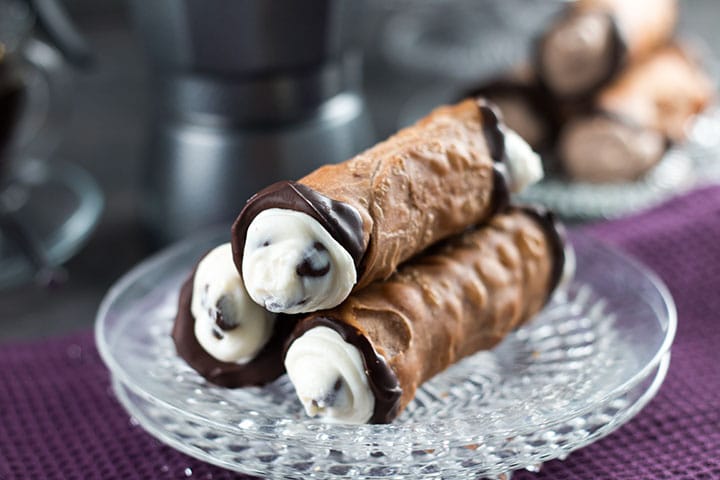
Making homemade Cannoli is a labor of love and the end result is a true pleasure. With the flaky, crispy shells and creamy filling, there are few desserts more incredible.
Cannoli from scratch may not something that can be whipped up quickly, but hopefully, I’ve come up with ways to make the process quicker and easier than you’ve seen before.
Growing up, my Italian Grandmother LOVED Cannoli. I’ll be honest, as a kid, I didn’t like them, but as I got older I began to appreciate them more and more. I now absolutely love them, but making them at home always seemed daunting.
Sadly, my Grandmother isn’t around anymore for me to ask for advice so this recipe took a few tries before getting it right. I made a couple of versions before I finally achieved, a crisp bubbled shell and thick, creamy filling that holds its shape.
To develop the recipe, I started with watching Mario Batali on YouTube. He gave some good advice – no recipe is the same and you can adjust the recipe to suit your taste. Making both the shells and filling sweeter, or more savory depending on taste. That was a great starting point and I ran with it.
My first attempt went pretty well flavor-wise, but the shells were too thick and didn’t bubble with that distinctive Cannoli look. 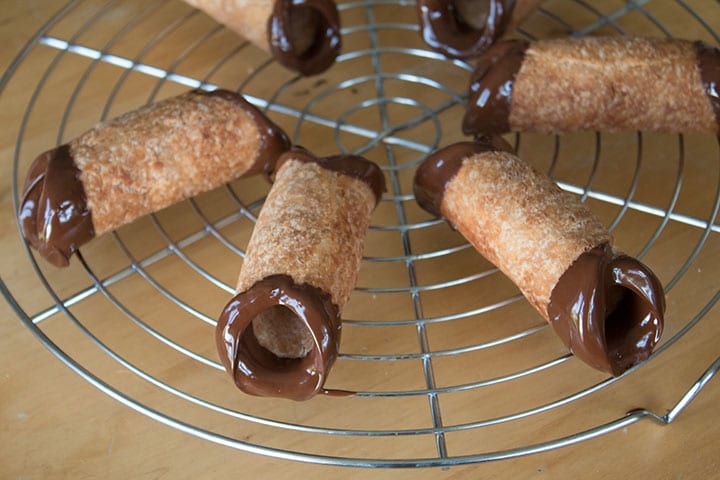
They tasted amazing though so I knew I was on the right track. I spent an entire Sunday trying to perfect it. In the end, they came out wonderful!
How to Make Cannoli Shells:
To make the dough for the shells quicker, I used a food processor. The process is very similar to making pie crust. You start with mixing together flour, cinnamon, cocoa powder, sugar, and salt.
Next, sprinkle in lemon juice and cold white wine and pulse with each addition until the dough just barely begins to hold together. You know that the mixture is ready if when you pinch some together with your fingers and it holds together.
Pour the dough onto a floured surface and knead until smooth. Then wrap in plastic wrap and let rest in the fridge for at least an hour. Once the dough is rested, it’s ready to roll.
As I mentioned before, the first time I made the shells I rolled it out by hand, but it was too thick and didn’t bubble when fried. In the end, I found running the dough through a pasta maker got the dough nice and thin (plus it was a lot quicker). For a good guide on doing this see this video on YouTube. I started on it’s thickest setting and ended with it on it’s 2nd to thinnest setting (which is a bit thicker than she did in the video)
Next, In a medium pot with a heavy bottom, start heating either shortening or the vegetable oil of your choice to 380 degrees F.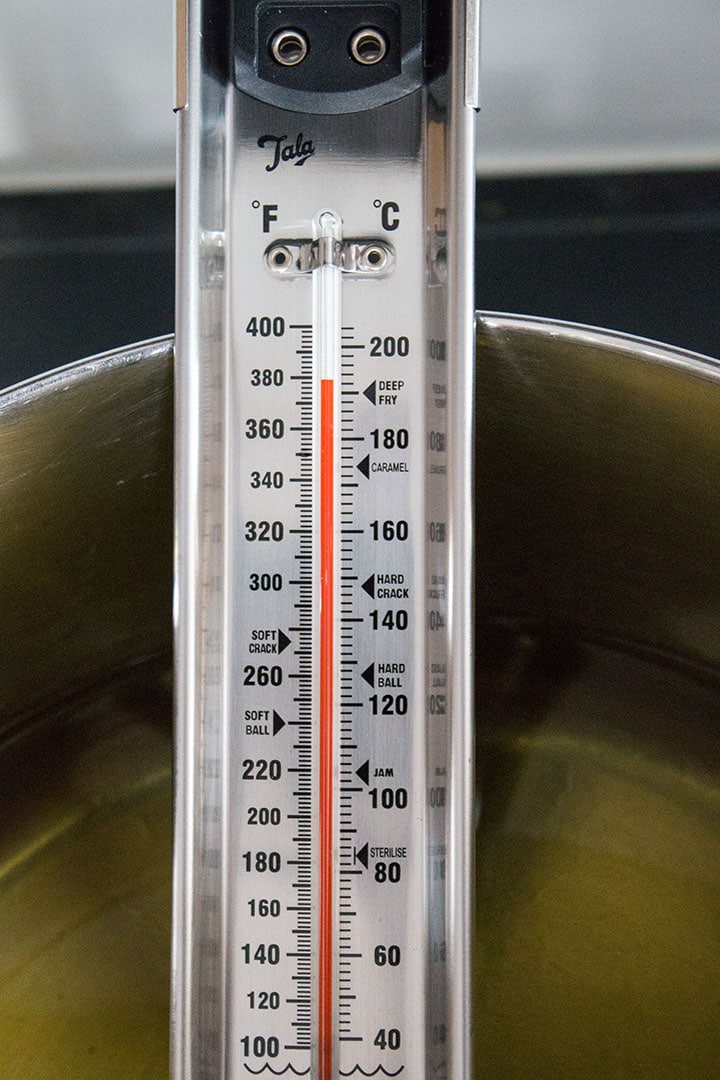
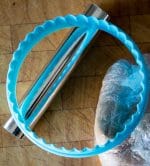 Cut the dough into rounds using a cookie cutter that’s a little smaller than the tube. Wrap each circle around a cannoli mold. Just before it’s completely wrapped, use a little of the egg wash on the edge then finishing wrapping and press it down to seal and to assure it won’t slide or fall off the mold during frying.
Cut the dough into rounds using a cookie cutter that’s a little smaller than the tube. Wrap each circle around a cannoli mold. Just before it’s completely wrapped, use a little of the egg wash on the edge then finishing wrapping and press it down to seal and to assure it won’t slide or fall off the mold during frying.
To fry the shells, use a pair of tongs to hold the edge of the mold as you submerge them in the oil and fry them until crispy (for me with the oil at 380F it took about a minute). Remove from the oil, and set aside on paper towel to cool. Repeat with all of the circles.
Once cool enough to handle, remove the tubes from the cannoli shells and place on a wire rack to cool completely. While the shells cool, you can start the filling.
How to make Cannoli Cream:
Ricotta cheese is an authentic ingredient to make Cannoli filling, but in Italy, the cheese is made fresh. It’s thicker and has no liquid in it unlike what we find in grocery stores. Making it straight from the container store bought will make a runny mess of a filling so the liquid needs to drain.
To do this line a strainer or colander with cheesecloth or paper towels. Place the strainer over a bowl and add put the ricotta onto the cloth. Cover, and place something heavy on top (I used a big jar of preserved lemons) and leave anywhere from 1 hour to overnight.
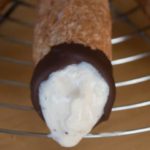 I like a thick filling so I wanted to use a mixture of ricotta and mascarpone cheese. My first attempt at making the filling wasn’t half bad. I used equal amounts of ricotta and mascarpone cheese with sugar, vanilla, lemon zest, and chocolate chips. It tasted great, but even with the strained ricotta, the filling was just too runny and it just fell out of the cannoli.
I like a thick filling so I wanted to use a mixture of ricotta and mascarpone cheese. My first attempt at making the filling wasn’t half bad. I used equal amounts of ricotta and mascarpone cheese with sugar, vanilla, lemon zest, and chocolate chips. It tasted great, but even with the strained ricotta, the filling was just too runny and it just fell out of the cannoli.The next time I made the filling, I used 3 parts mascarpone cheese and one part strained ricotta. This came out much thicker and creamier.
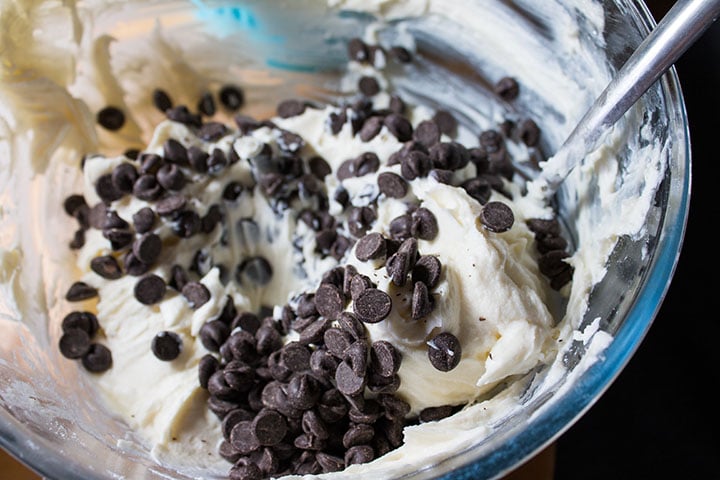
Note: The filling can be made up to 1 day ahead and refrigerated and covered.
Assembling the Cannoli :
I dipped my shells in melted dark chocolate. This step is completely optional. Traditionally the ends are covered in tiny chocolate chips, but I couldn’t get a hold of them so I thought this would be a nice alternative.
To have the dipped ends, just dipped the cooled shells just melt the chocolate and dip each end of the shells into the chocolate and leave to set completely on a wire rack before filling.
To fill the Cannoli, you can use a piping bag or a bag with a corner cut out to pipe the filling in.
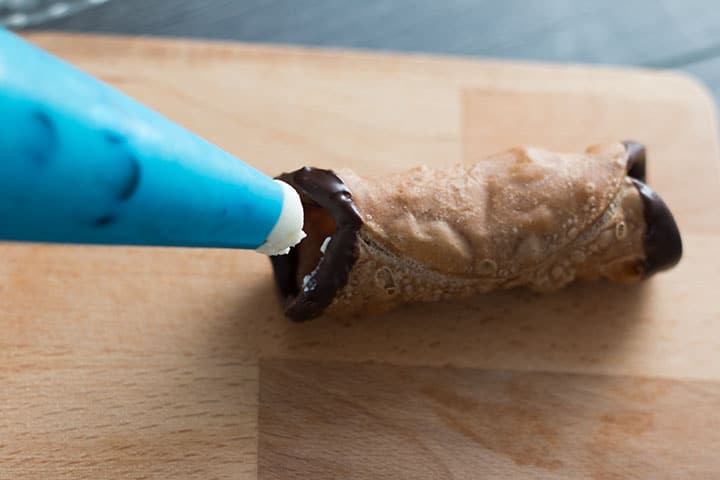
If you’re using a decorative tip, make sure the opening is wide enough to accommodate the chocolate chips or it will clog the tip. Start piping on one end and when the filling reaches the halfway mark, start filling the other side until it’s completely full.
Can you make cannoli filling in advance?
You can make cannoli filling up to three days in advance. Just prepare the mixture and fill just before eating. Storing the cannoli filled will make the shells soggy. Filling just before eating will result in a crunchy, crisp delight.
★ Did you make this recipe? Please give it a star rating below!

Homemade Cannoli
Learn how to make homemade cannoli with this easy to follow recipe. A classic Italian pastry with a crisp shell and creamy, sweet ricotta & mascarpone cheese filling.
Total Time 1 hour 5 minutes
Ingredients
For The Shells
1½
cups
all-purpose flour
1⁄2
teaspoon
ground cinnamon
2
teaspoon
cocoa powder
3
tablespoons
sugar
superfine if you can find it
1⁄2
teaspoon
salt
3
tablespoons
butter
chilled and cut into cubes
4
tablespoons
Lemon Juice
4
tablespoons
white wine
For The Filling:
1⁄2
lb
ricotta
drained at least 1 hour in a cheesecloth lined strainer
3⁄4
lb
mascarpone cheese
3⁄4
cup
sugar
superfine if you can find it
1⁄2
cup
miniature chocolate chips
1
tablespoon
vanilla extract
1
teaspoon
lemon zest
optional
6
oz
dark chocolate
chopped
For Deep Frying:
vegetable oil
varies depending on the size of the pot you use - fill to a depth of 3 inches
1
egg
lightly beaten
Instructions
Preparing the dough:
In a Food processor, mix together flour, cinnamon, cocoa powder, sugar, and salt.
Add the cubed, cold butter and pulse 6 to 8 times until the largest pieces of butter are about the size of large breadcrumbs.
Sprinkle in lemon juice and cold white wine and pulse with each addition until the dough just barely begins to hold together. You know that the mixture is ready if when you pinch some together with your fingers and it holds together.
Turn out dough onto a floured surface and knead until smooth. Wrap with a sheet of plastic wrap, and refrigerate 45 minutes to 1 hour.
Making The Filling:
In a medium mixing bowl, stir together ricotta, mascarpone cheese, sugar, chocolate chips, vanilla, and lemon zest. Spoon the mixture into a pastry bag with 1/2 inch cut in the tip and refrigerate until ready to use.
Assembly and Frying:
To roll the dough by hand, dust a work surface lightly with flour. Cut the dough in half; start with one half of the dough and keep the other half wrapped until ready to use. Roll each half out to at least 1/8-inch thick.
If using a pasta maker, set the pasta roller on the widest setting (number 0 or 1). Flatten the dough as much as you with your hands can to help it going through the pasta roller. Run the dough through the roller twice, dusting it with flour in between rolls if it feels sticky, and then fold in half. (When rolling out pasta dough, always hold the pasta on the tops of your hands with your palms down. If you hold it fingers up you will create stretch marks).
Move the roller to the next setting and run the dough through. Continue to run the dough through the machine, reducing the opening in between every roll. Stop when you get to the correct thinness, this will be around number 5 on the dial, but every machine is different and see the photos for thickness.
Fill a large heavy bottomed, pot with oil to depth of 3 inches. Heat over moderate heat until thermometer registers 375° - 380° F
Beat the egg with 2 tablespoons of water.
Cut rounds from dough. Wrap each circle around a cannoli mold. Use a little of the egg wash on the edge of each round to seal it shut and to assure it won't slide or fall off the mold before pressing it closed over the mold.
Use a pair of tongs to hold the edge of the mold as you submerge and fry the shell in the oil until crispy (at 380° mine took a minute). Transfer to paper towel–lined platter to drain and cool about 5 minutes. Stand tubes upright and tap gently against counter top to loosen shells. Twist molds to remove shells.
Melt the chocolate and dip each end of the shells into the melted chocolate. Let stand on a wire rack to cool and set completely.
When ready to serve, pipe filling into 1 end of cannoli shell, filling it halfway, then pipe into the other end. Repeat to fill remaining shells.
Nutrition Facts
Homemade Cannoli
Amount Per Serving
Calories 329
Calories from Fat 171
% Daily Value*
Total Fat 19g
29%
Saturated Fat 12g
60%
Cholesterol 45mg
15%
Sodium 125mg
5%
Potassium 113mg
3%
Total Carbohydrates 30g
10%
Dietary Fiber 1g
4%
Sugars 17g
Protein 5g
10%
Vitamin A
9.2%
Vitamin C
2%
Calcium
7.7%
Iron
11.1%
* Percent Daily Values are based on a 2000 calorie diet.








0 komentar: